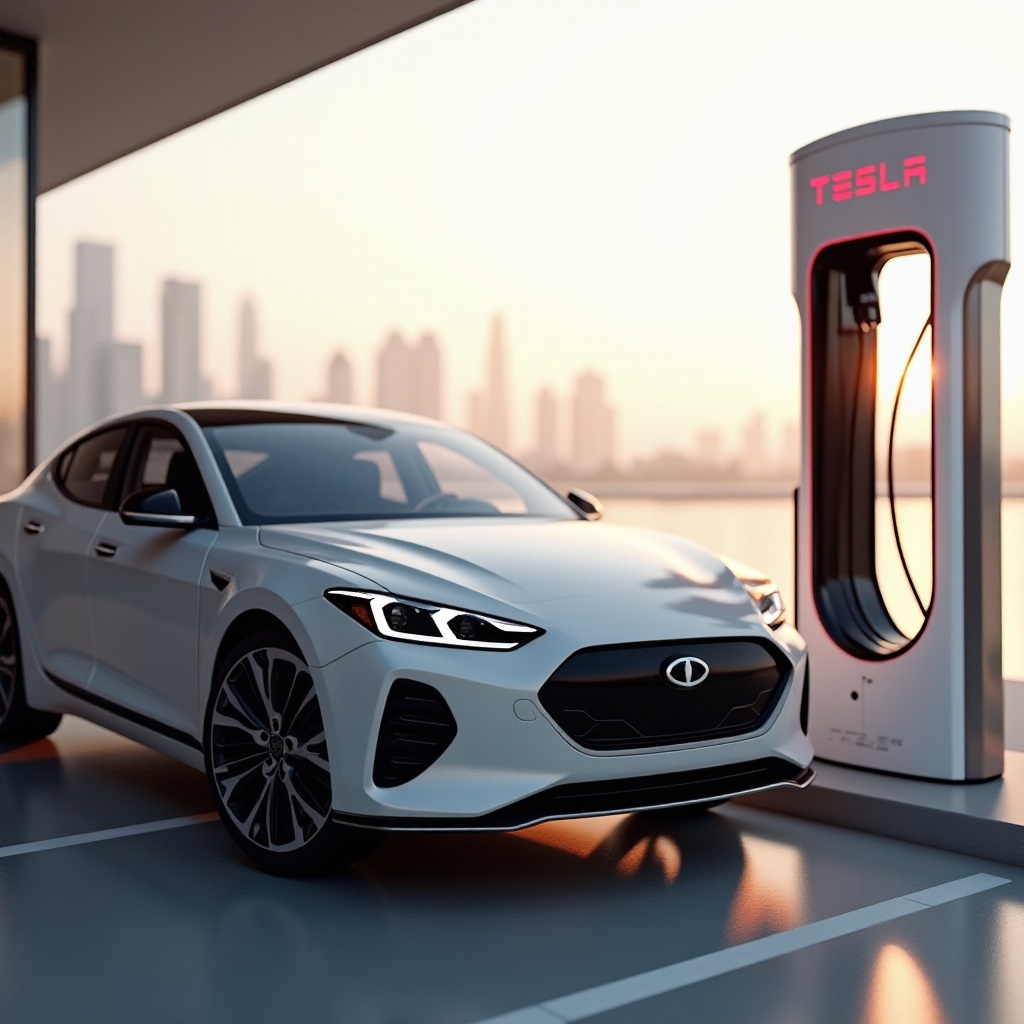Introduction
The rise of electric vehicles (EVs) has led to the expansion of various charging networks, leaving many EV owners questioning compatibility. Hyundai’s Ioniq 6, a noteworthy EV, raises questions about its interoperability with the widespread Tesla Supercharger network. By delving into EV charging standards, the Ioniq 6’s specific charging capabilities, and the exclusive features of Tesla Superchargers, we can uncover the answer.

Understanding EV Charging Standards
EVs depend on specific charging standards to ensure secure and efficient power transfer. The most common standards are CHAdeMO, Combined Charging System (CCS), and Tesla’s proprietary system. Each standard accommodates different plug types, power levels, and communication protocols. By understanding these nuances, one can appreciate how various EV models might utilize specific charging networks.
The CHAdeMO standard, originating in Japan, is primarily used by Asian car makers. CCS, popular in Europe and the US, combines AC and DC charging capabilities in one plug, offering versatility. Tesla’s Superchargers use a unique plug designed for high power levels, enabling rapid charging but also presenting compatibility challenges for non-Tesla vehicles.
Hyundai Ioniq 6 Charging Capabilities
The Hyundai Ioniq 6 comes equipped with advanced charging technology, making it a formidable contender in the EV market. It adheres to the CCS standard, compatible with Type 2 connections in Europe and the US. The charging infrastructure for the Ioniq 6 ranges from standard home outlets to rapid DC fast chargers.
With its CCS compatibility, the Ioniq 6 can efficiently utilize most fast-charging stations, offering drivers flexibility and convenience. The vehicle’s onboard charger also supports AC charging at up to 7.2 kW, ideal for overnight home charging. Understanding these capabilities is crucial as we examine its compatibility with Tesla’s infrastructure.
The Tesla Supercharger Network Explained
Tesla’s Supercharger network is famous for its speed, reliability, and extensive coverage. Designed exclusively for Tesla vehicles, these chargers can deliver up to 250 kW, significantly cutting down charging times. The network has expanded robustly, featuring thousands of stations worldwide, ensuring Tesla owners can charge their vehicles quickly almost anywhere.
However, this exclusivity poses a challenge for non-Tesla EVs. Tesla’s system employs proprietary connectors and communication protocols, which are not natively compatible with other brands. A closer look at these technical aspects will help determine whether and how the Hyundai Ioniq 6 can access this network.
Compatibility of Ioniq 6 with Tesla Superchargers
Technical Aspects
Technically, Tesla Superchargers have a unique plug design, different from the CCS standard used by the Ioniq 6. This difference means direct compatibility is not feasible without an adapter.
Adapters and Converters
Several third-party companies have developed adapters that enable non-Tesla EVs, like the Ioniq 6, to use Tesla Superchargers. These adapters bridge the gap between Tesla’s proprietary connectors and the CCS standard. However, it is crucial to ensure these adapters are certified and reliable to avoid damaging the vehicle or the charging infrastructure.
Communication Protocols
Effective communication between the vehicle and charger is crucial for managing power delivery and ensuring safe charging. Tesla’s Superchargers use a proprietary protocol unlike the open standards used in CCS. This discrepancy can pose challenges since the car and charger need to effectively ‘talk’ for the charging session to proceed smoothly.
Experiences and Case Studies
Exploring real-life experiences and case studies sheds light on practical compatibility. Some Ioniq 6 owners have successfully charged their vehicles at Tesla Superchargers using third-party adapters. Their feedback generally indicates that with the right equipment, the process is smooth, albeit sometimes slower due to adapter performance limitations.
These user experiences underscore the importance of using quality adapters and being well-informed about mixed-network charging intricacies. They offer practical insights into the feasibility of using Tesla Superchargers with the Ioniq 6.
Benefits and Drawbacks
Using Tesla Superchargers with a Hyundai Ioniq 6 presents several benefits and drawbacks.
Benefits:
- Convenient and fast charging through Tesla’s vast network.
- Reduced range anxiety due to widespread charger availability.
- Leveraging high-speed charging for quick power boosts during long journeys.
Drawbacks:
- The cost of purchasing reliable adapters.
- Potential slower charging speeds due to non-native compatibility.
- Possible warranty issues or risks associated with third-party accessories.

Future Prospects
Looking ahead, the EV market is evolving towards increased interoperability. Tesla has hinted at opening its Supercharger network to other EV brands in select regions, signaling a more collaborative future for charging infrastructure. This shift could reduce compatibility issues significantly and make high-speed charging accessible to all EV owners, including Hyundai Ioniq 6 drivers.
Manufacturers are likely to push for universal standards to facilitate seamless charging experiences, ensuring industry growth and consumer satisfaction. Keeping an eye on these developments will be key for EV owners seeking versatile charging options.

Conclusion
In conclusion, while the Hyundai Ioniq 6 lacks native compatibility with Tesla Superchargers, adapters can bridge this gap. Users should carefully weigh the benefits against potential drawbacks and risks. As the industry moves toward greater interoperability, future advancements may simplify the charging process for all EV owners.
Frequently Asked Questions
Can Ioniq 6 charge at any Tesla Supercharger station?
Yes, if you use a compatible adapter, the Ioniq 6 can charge at Tesla Superchargers, where Tesla permits access to non-Tesla vehicles.
Are there any risks to using adapters with the Ioniq 6?
Using adapters can pose risks, including potential damage to the vehicle or charger and voiding warranties. It’s crucial to use high-quality, certified adapters.
How does the charging speed compare between Tesla Superchargers and other networks?
Tesla Superchargers are among the fastest available. However, when using adapters, the Ioniq 6’s charging speed may be slower and can vary based on the adapter’s efficiency.
